Day 11: Hoa takes us to the Hue airport early the next morning, where we catch our final plane leg to Saigon. After ten days of temperate to cool weather, we step out into sauna-like temperatures.

Staff welcome us to our Saigon hotel
Whether you call this city “Saigon” or “Ho Chi Minh City” is a sensitive issue to some, depending on which side you found yourself on during the Vietnam War. On April 30th, 1975, North Vietnamese troops captured Saigon and renamed it “Ho Chi Minh City” to honor the Communist leader. Although this is the official name of the city, many continue to use the old name, and the main river that flows through the city is still the Saigon River.
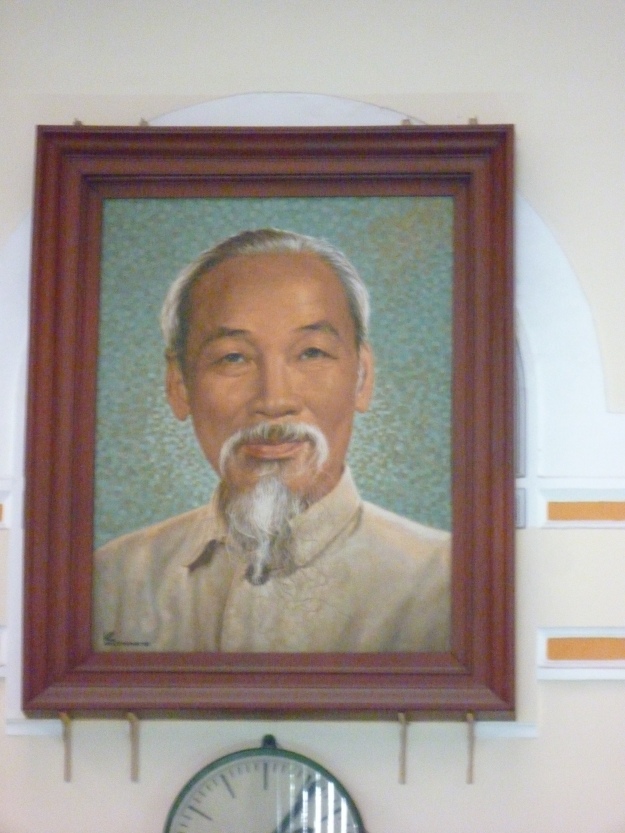
Ho Chi Minh is Everywhere. (Portrait in Saigon Post Office.)
Our Saigon city guide picks up us and takes us for a city tour of the colonial-era post office, followed by a small factory and retail store where disabled people – including many war casualties – create lovely pieces for the tourist market. We’re not sure how much of the proceeds the artisans make. We visit a large, noisy, pungent wholesale market where you can buy almost anything. We also do a self-guided tour of the Ben Thanh retail market near our hotel. It’s hot, and we are soon looking for ice cream.
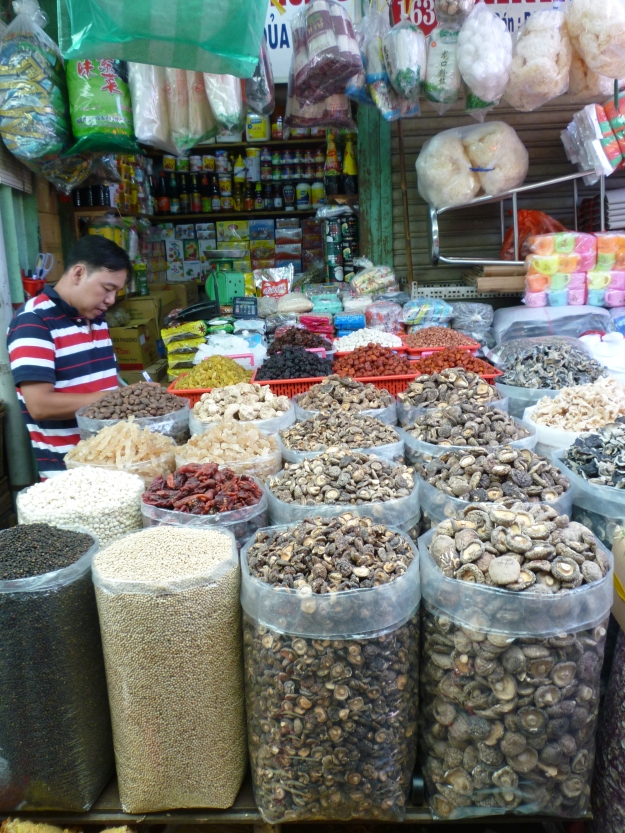
Wholesale Herb & Fungus Counter
Our new cycling guide, Hai, picks us up the following morning and we take a two-hour van trip out of Saigon, heading into the Mekong Delta. We are relieved to not be cycling in Saigon, which is hot and crowded, although it seems a little less chaotic than Hanoi. Hai tells us that this is this fifth profession. He was a farmer, teacher, fortune teller, priest – almost, until he met his future wife – and now he’s a travel guide. His father fought for the South in the Vietnam War and was imprisoned following “Reunification.” He died in prison a couple of years later.
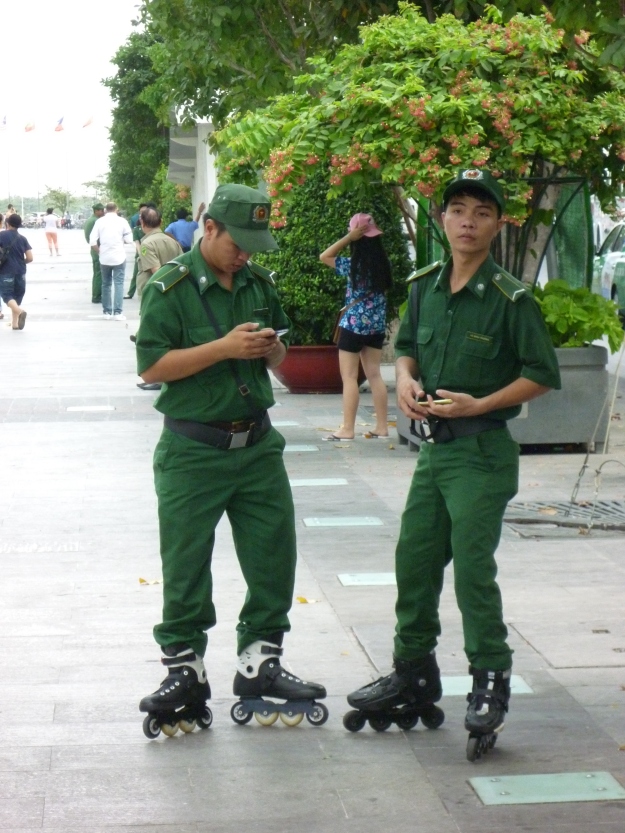
Modern Police Presence in Ho Chi Minh City
Gathering our bicycles between My Tho and Cai Lay we catch a tiny ferry to an island, cycle over it to another ferry, disembarking on the island of Tan Qui. The paved pathways are narrow, and used by many others on foot, bicycle, and scooter. Frequent bridges rise over shallow canals and sloughs, and passing is often tight.
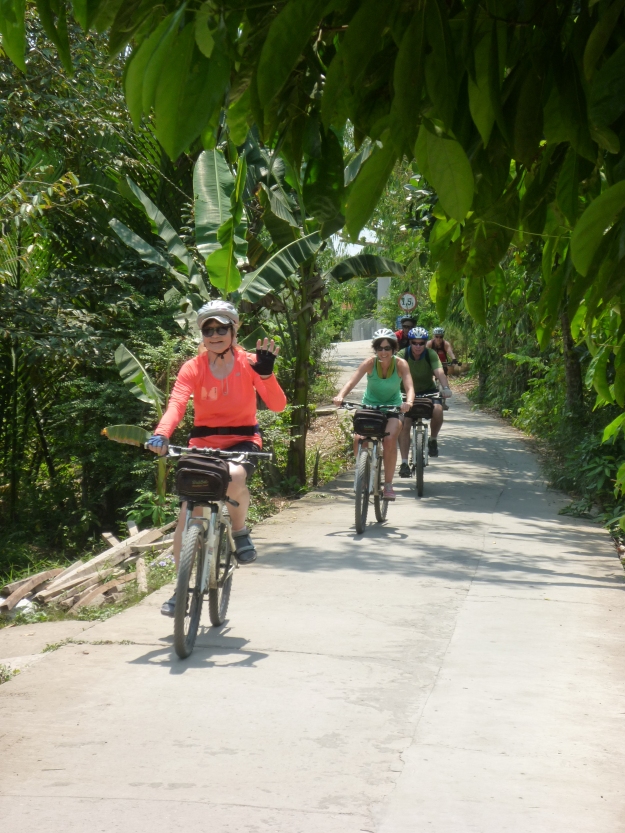
One of the Wider Paths on the Delta Islands – note the added “passing lane”
I have my clip-on side-mirror knocked off by a passing scooter, but fortunately, it isn’t damaged. (Nor am I.) We see lots of jackfruit growing beside the pathways, and continue to be amazed by how large and varied are the loads that can be carried on the scooters.
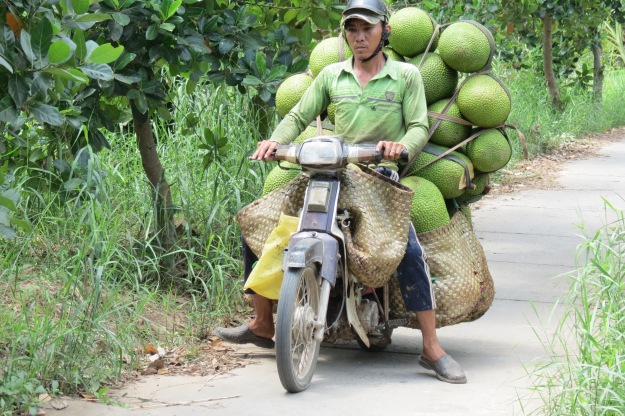
A load of jackfruit passes en route to market (Photo by Rob Mudie)
We catch a tourist boat and tour the larger waterways of the Mekong River where large floating markets used to flourish, but are now much diminished. We stop for lunch at an open-air restaurant on the water and gawk at a beautiful elephant-ear fish presented to us for lunch. The waitress teaches us how to make spring rolls from its white flesh. (Yes, we are still eating spring rolls for every meal!).

It tasted even better than it looked!
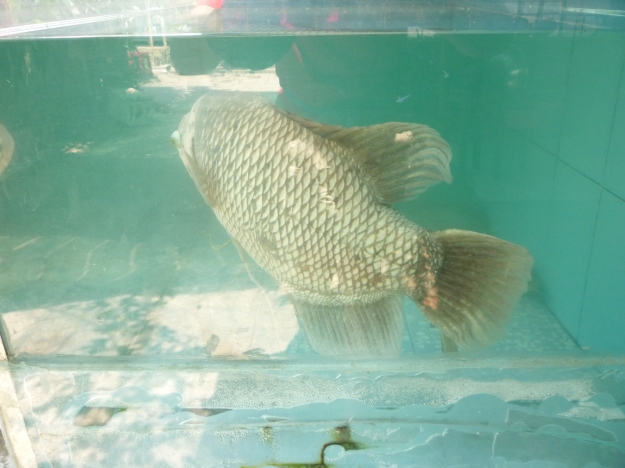
An Elephant Ear Fish soon to be someone else’s lunch
During the afternoon, we also pass an unusual Cao Dai temple. Caodaiism is a uniquely Vietnamese religion, that sounds like an amalgam of all of the world’s major religious traditions and beliefs. Founded in the south of the country in 1926, it was banned by the communists between 1975 and 1997, but currently has about four million adherents. These numbers put it behind Buddhism and Catholicism – the latter a legacy of French colonial rule – but ahead of Islam and Hinduism.

The All-Seeing Divine Eye caps a Cao Dai temple
The twisty tree-shaded paths crisscross the islands of the Mekong Delta, with branches around every corner. It’s hard to tell one lane from the next, and we try to stay close to the rider ahead of us. At one junction, Paul and I realize we’ve lost the scent, and alight to reconnoiter. We don’t want to guess at the correct direction, and decide to wait until someone notices and returns to see what happened to us.
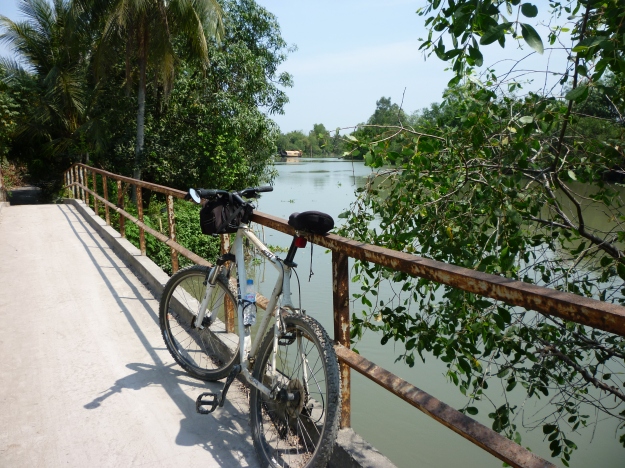
A peaceful moment on one of the larger bridges over a Mekong channel
The minutes tick by, and we listen to the sounds of cicadas, as well as commerce at the local corner “store,” really no more than a couple of shelves outside a path-side home. Eventually, Hai comes cycling back and we’re reunited. En route, we learn that one other of our number had also lost their way, and made a guess. Fortunately, he guessed right. Two days later he was less fortunate.

A Catholic Church on a Mekong Island
We can imagine how easy it would be for Viet Cong infiltrators to hide out in the Mekong Delta. Aside from the dense cover, even the river and tributaries are filled with meandering bunches of water hyacinth. According to Hai, the Viet Cong would often hide in the water using lumps of the floating plant to camouflage their movements. Today there is enough vegetation floating by to hide an army.

Water Hyacinth floats by a Middle-Class Dwelling
We take another ferry across hyacinth-spotted waters, then pedal a few kilometers to spend the evening at a lovely homestay set on a large estate. The rooms even have air-conditioning, which we appreciate. At the start of dinner, we have another lesson in the making and eating of Vietnamese pancakes.
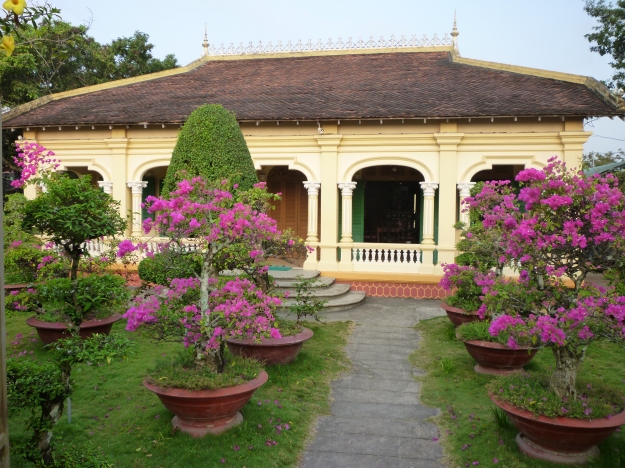
Our homestay in this comfortable estate built in the 1800s
Day 12: The following cycle day is a very busy one. We visit a local black pepper plantation, as well as a brick kiln.
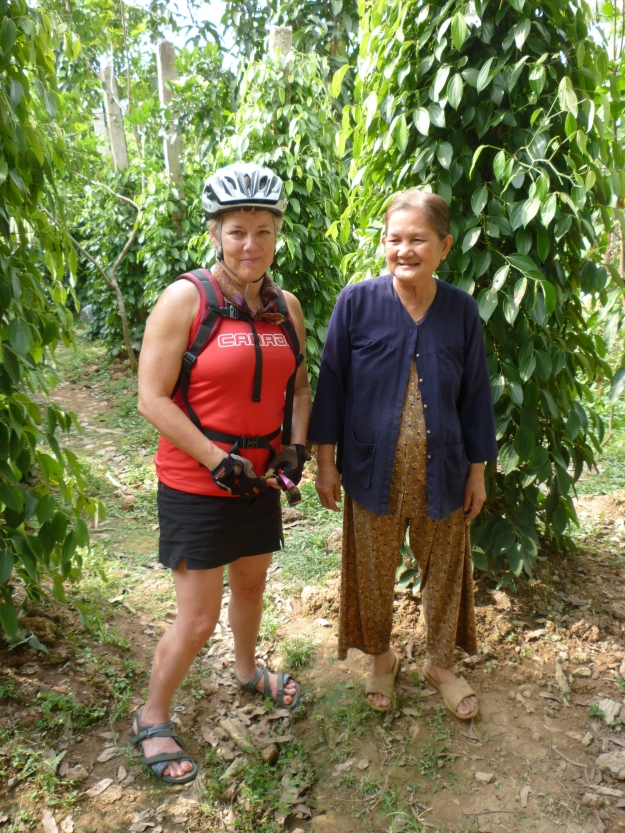
This farmer was happy to show off her newly planted black pepper plants
The kiln is fueled with rice husks, but this practice may be discontinued in the future, due to the amount of smoke and pollution generated. We watch a lady make rice paper with rice flour and mineral water. She steams it, removes the thin paper and dries it for two days in the sun, resulting in a very hard circle of rice paper.
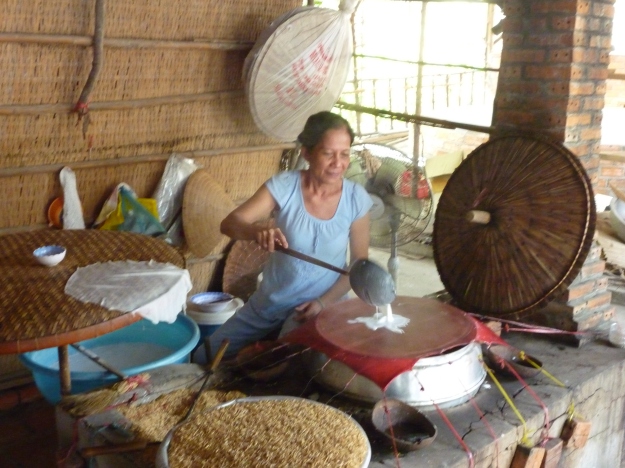
Rice paper is used to wrap the salad rolls we learned to make earlier
A man demonstrates the creation of ‘popcorn’ when he heats sand, pours rice into it, and filters the result through a sieve. The product tastes a lot like puffed rice, which is to say, rather bland.
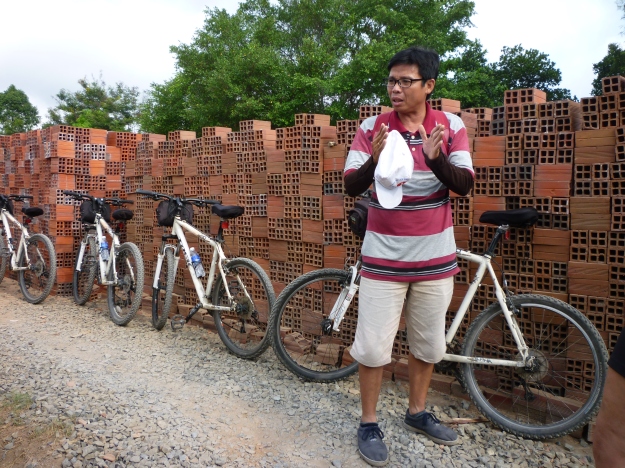
Hai explains brick making methods at a canal-side kiln
We find ourselves in front of a large bottle of 40-proof rice wine filled with layers of dead venomous snakes. Apparently they are put into the strong wine alive, and they respond by emptying their venom sacs while expiring. According to tradition, the wine is ‘guaranteed’ to promote strength and longevity.
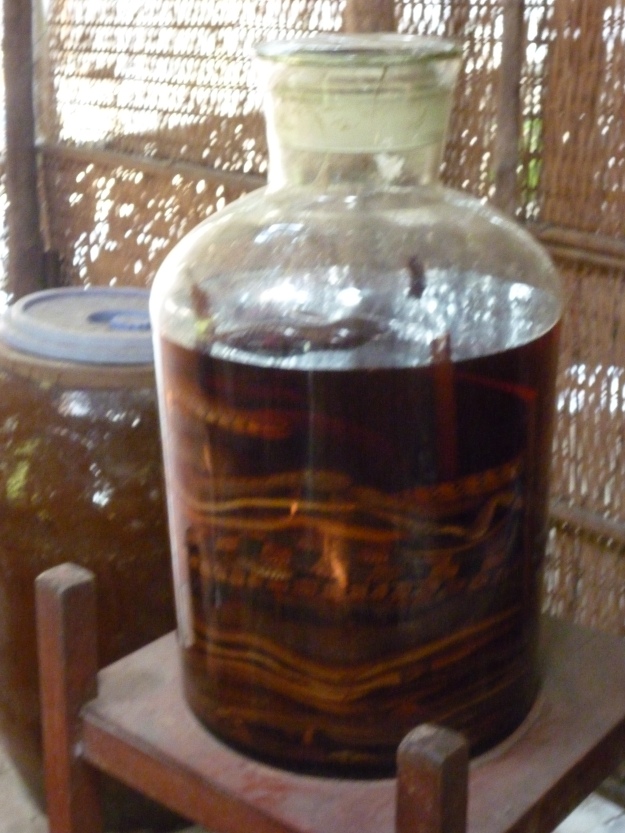
“Mot, hai, ba, yo!” (Did I really drink that snake wine?!)
Before we have a chance to think rationally, we find ourselves with a thimble of the concoction in our hands, and with a ‘mot, hai, ba, yo’ it’s down the hatch. We notice that there are many bottles of rice wine filled with all types of snakes and scorpions for sale, but we decide that it’s unlikely we’d get them through customs, so choose not to purchase them. That’s the only reason, I swear. Paul looks a little green, but he swears he feels stronger.
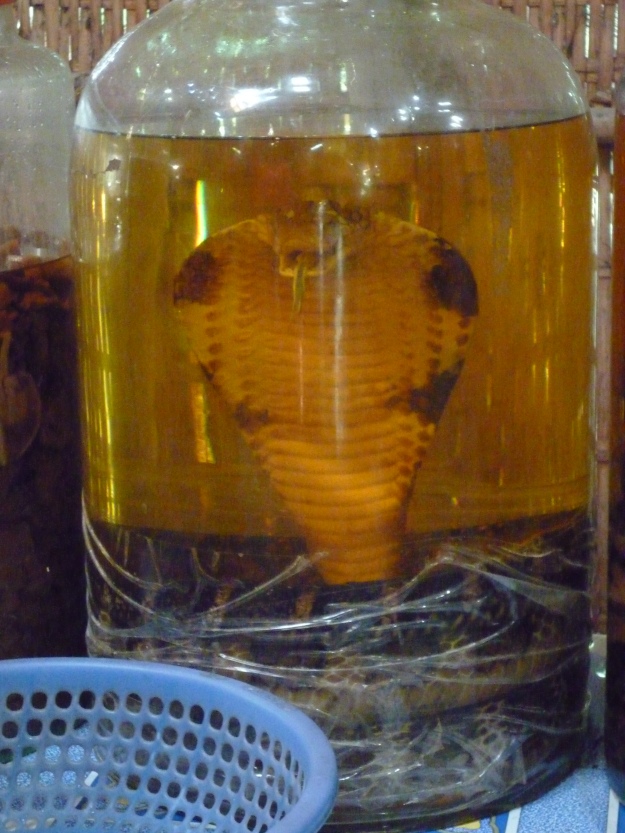
Can we buy this at the Duty Free?
We cycle past a couple of men cooking rats over an open fire. They are called ‘rice rabbits’ here, perhaps to make them more palatable, but while we consider ourselves pretty game for most things, we decline to partake in this delicacy when offered. Hai told us he got used to eating them during the lean years in the early 1990s, and finds them tasty with a good sauce.
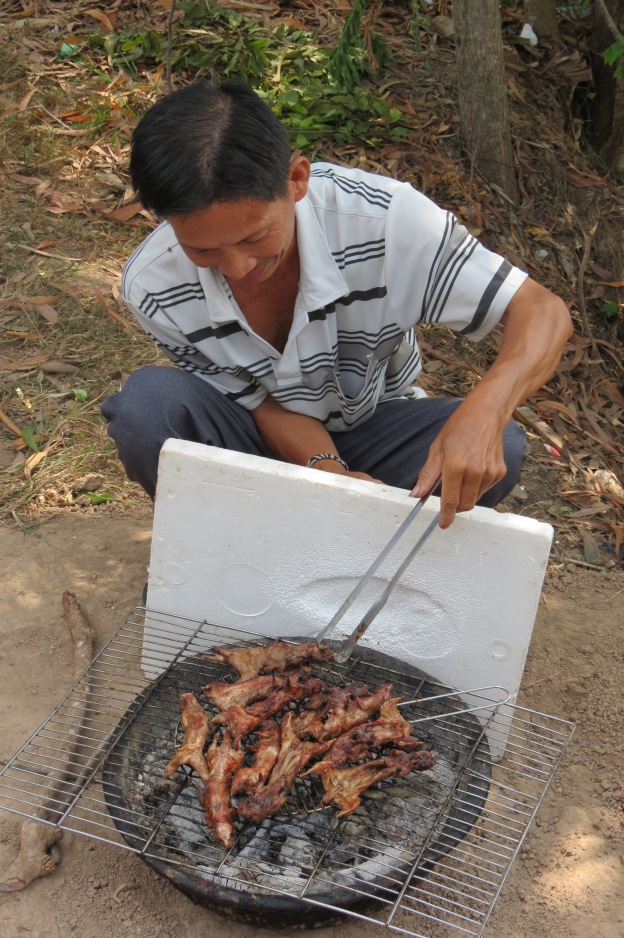
Would you like soy sauce with your “rice rabbit,” Ma’am?
He takes us to a small coffee shop to try durian. It is the stinkiest fruit on the planet and in some apartment buildings it’s banned. The first durian he purchases he opens and declares ‘bad’, and goes out to get a new one, which he declares ‘really good’. We can’t tell the difference.

When it comes to Durian, I’m afraid I’m in the other 95%
The sloppy flesh takes a lot like smelly cheese, and Hai tells us that Vietnamese love this fruit, but only about 5% of the rest of the world cares for it, so it has little export potential. We head back to Saigon after this busy day. Two hours later, Paul says he can still taste something like stale Limburger.
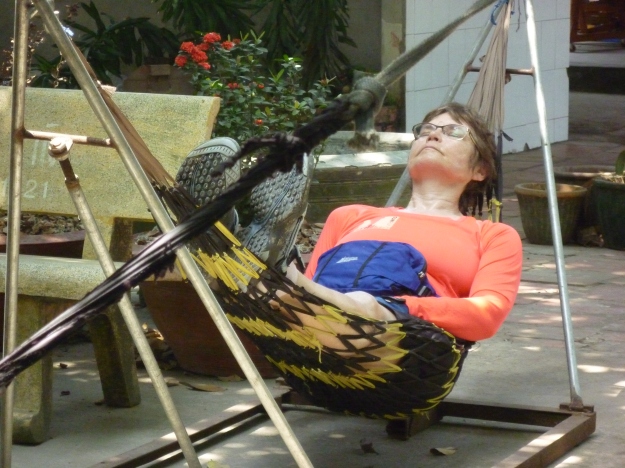
Coffee in a hammock seems a more palatable custom
Day 13: Our last cycle day we head out of Saigon again, and take a 30 km cycle through the rice fields and rubber plantations around the Cu Chi tunnels. After lunch, we visit the tunnels where local villagers who sympathized with the Viet Cong for years hid from US and South Vietnam troops in a 250-kilometer network of tunnels. At one time, over 16 thousand men, women and children lived underground.

Tunnel air vents were hidden in forest termite mounds
Tunnel entrances were sized to admit only the narrow shoulders of the generally small Vietnamese people. The area was peppered with lethal man-traps. In many areas, there were three levels of bunkers; the lowest, more than 30 feet below ground level, could usually protect the tunnel-dwellers from bombs dropped from B-52s. Still, more than half the tunnel dwellers were eventually killed during the Vietnam War.

Rob tries out one of the larger tunnel entrances
That evening back in town, we savour our last meal on an IndoChina junk on the Saigon river, enjoying the warm evening and beautiful skyline of the city. And although the food is good, it’s pretty unanimous that we won’t eat another spring roll for a month or two.
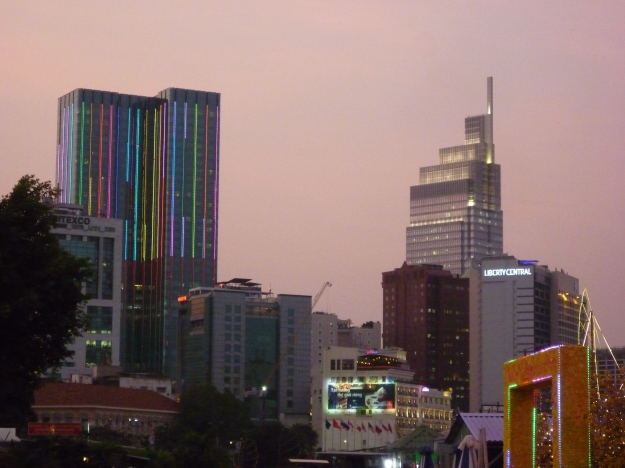
Saigon’s skyline from the River looks as modern as any
Day 14: The next day we visit a local museum, where Rob, the collector in our group, continues to find Tin Tin paraphernalia (while Rose rolls her eyes and tries to figure out where each new purchase will reside in their home.) We don’t really understand why Tin Tin is such a big thing here in Vietnam, but Rob is in seventh heaven. We way our goodbyes at the hotel as we catch our ride to the airport for our flight to Sydney. The other four in our party will fly to Cambodia to continue their cycling adventures the next day.
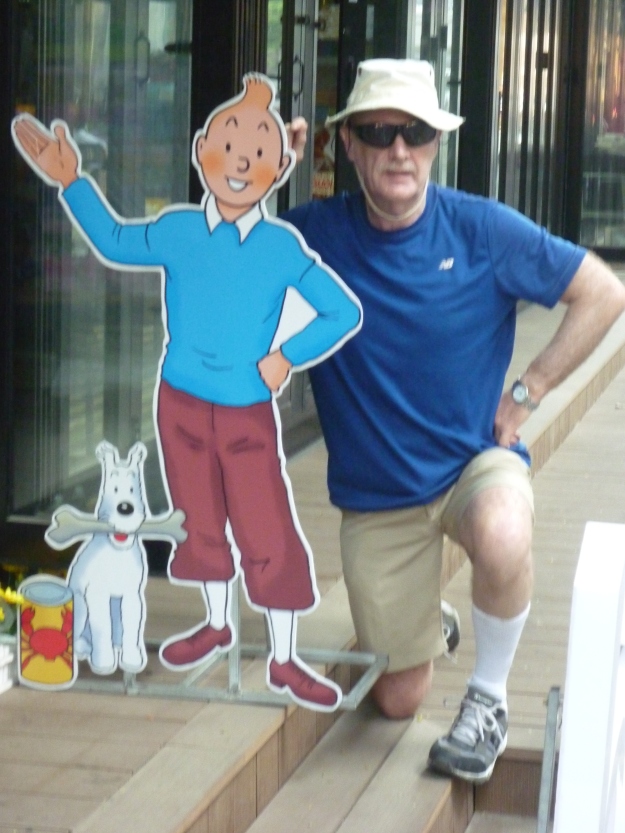
Tin Tin and Friend, in Saigon
We’ve had some interesting and varied cycling over the past couple of weeks. All our guides were very different, but each of them was friendly, helpful and knowledgeable. We feel they truly enjoyed meeting us and letting us experience a little of their country and customs. We learned as much about the culture as we could have expected, and were very well fed. But it might have been interesting to know what the locals were eating when spring rolls weren’t on the menu!

The owner’s youngster has it better than most Vietnamese children
For more information:
- Lac Viet – our tour operator
- Biketours.com – the US company that did all the arangements
- Cao Dai Religion
- Cu Chi Tunnels
Related posts:
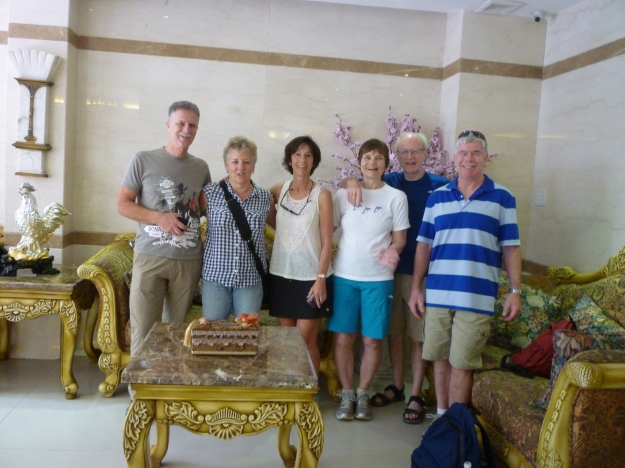
Ready to go our separate ways – It’s been a great two weeks

Pingback: Cycling in Vietnam – Central: Hue & Hoi An | No Pension, Will Travel
You have such terrific blogs. Thanks so much for sharing. Passing them on to my son who’s
going to Vietnam in May.
Thanks, Gillian, we hope they she’d some light. Feel free to have him contact us if we can help with any questions. See you soon.
Check the photos with Tin Tin and Ho Chi Minh. Add a beard to Tin Tin and voila!
It all makes sense. Tin Tin went to Hanoi and took on a disguise. Hmmm.
Thanks so much for sharing your adventures. I am really enjoying them. I suspect ‘P3’ shall not be having any elephant-ear fish or Durian soon, but we try to convince them.
P.S. Obviously ‘P3’ is an inside joke, its a little hole in the wall bar near New Westminster BC, okay, simply a ‘hole’, that Cheryl drags her work friends.
We’received bringing home a recipe for Rice Rabbits, just in case. 😉
Looks like a great tour! I did the Mekong Delta only by boat and on foot ten years ago, cycling looks like such a sensible choice! We are in Saigon right now but I missed those policemen on rollerblades…nice post, thanks for sharing!
Kerstin
Thanks, Kerstin. Cycling always seems a great way to explore a place – just the right pace.
Some more terrific sights and experiences. The pictures tell a good story. Thanks for sharing.
Thanks, Darlene. It does seem we had more to say about this leg.